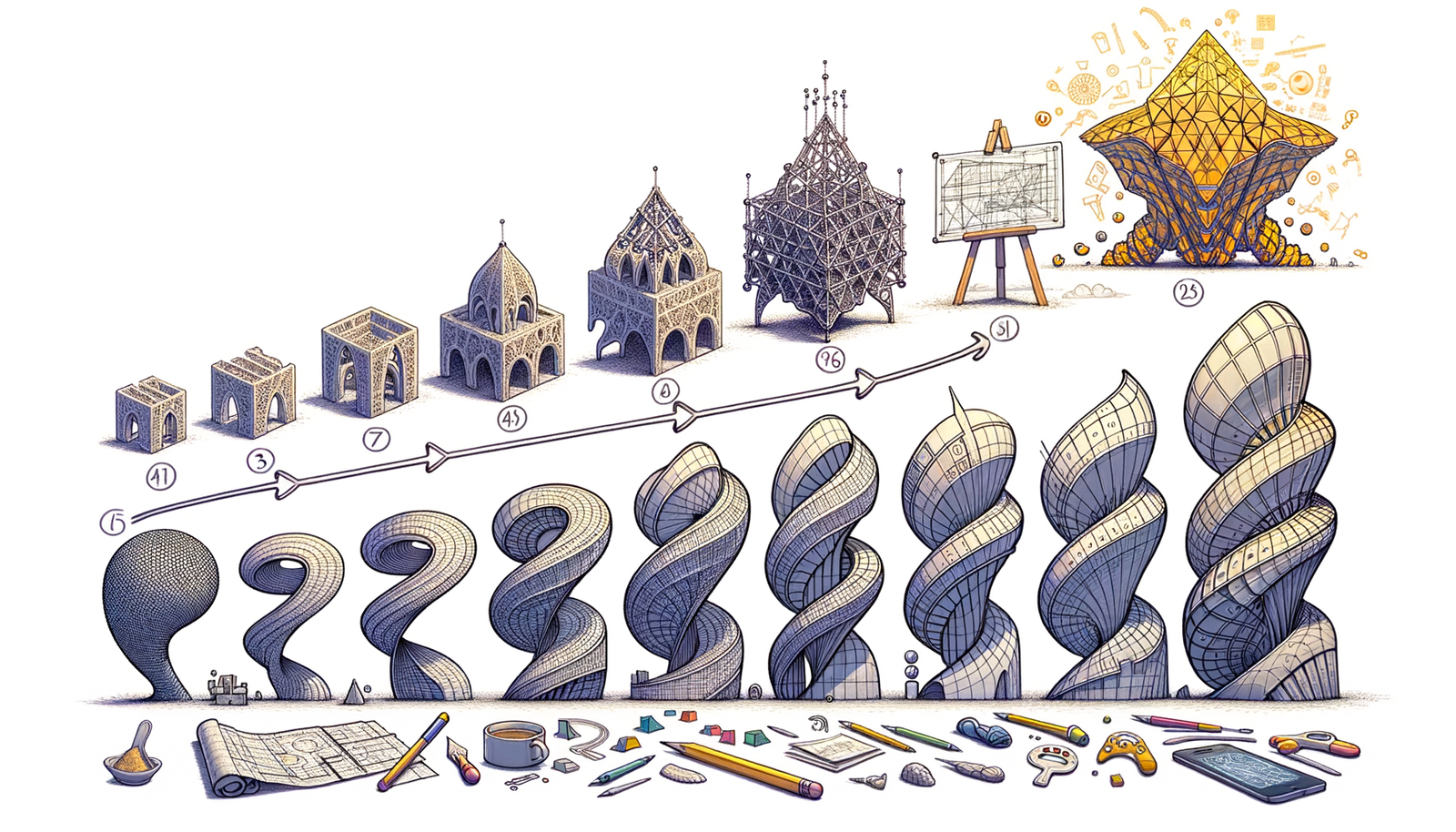Your Cart is Empty
Customer Testimonials
-
"Great customer service. The folks at Novedge were super helpful in navigating a somewhat complicated order including software upgrades and serial numbers in various stages of inactivity. They were friendly and helpful throughout the process.."
Ruben Ruckmark
"Quick & very helpful. We have been using Novedge for years and are very happy with their quick service when we need to make a purchase and excellent support resolving any issues."
Will Woodson
"Scott is the best. He reminds me about subscriptions dates, guides me in the correct direction for updates. He always responds promptly to me. He is literally the reason I continue to work with Novedge and will do so in the future."
Edward Mchugh
"Calvin Lok is “the man”. After my purchase of Sketchup 2021, he called me and provided step-by-step instructions to ease me through difficulties I was having with the setup of my new software."
Mike Borzage
Design Software History: The Evolution of Parametric Design: From Mathematical Foundations to Modern Architectural Practices
February 09, 2025 7 min read


Parametric design has emerged as a transformative force in the realm of architecture and design, offering unprecedented flexibility and efficiency in creating complex forms and systems. By integrating mathematical parameters into the design process, it allows designers to manipulate and adjust variables dynamically, leading to innovative solutions that were previously unattainable.
Definition and Overview
Parametric design is a method of design that utilizes algorithmic thinking to encode relationships between design intent and design response. It involves the use of parameters—variables that define a system and determine its behaviors—to manipulate and inform the design of complex geometries and structures. This approach enables designers to create models where changes to one element automatically propagate throughout the entire model, maintaining consistency and coherence.
Unlike traditional design approaches, which often rely on static representations and manual adjustments, parametric design leverages computational tools to create dynamic models. Key characteristics of parametric design include the ability to generate multiple design iterations rapidly, facilitate complex geometries, and integrate performance criteria directly into the design process. By contrast, traditional methods may require significant time to adjust designs and may not easily accommodate changes without substantial rework.
In parametric design, the relationship between elements is explicitly defined, allowing for a more fluid and responsive design environment. Designers can set up rules and constraints that govern the behavior of design components, leading to a cohesive and integrated approach. This paradigm shift has enabled architects and designers to explore forms and structures that were previously impractical or impossible to conceive using conventional techniques.
Some of the key benefits of parametric design include:
- Enhanced flexibility in design modifications and iterations.
- Improved efficiency through automated adjustments.
- Ability to handle complex geometries with precision.
- Integration of performance analytics into the design process.
- Facilitation of collaboration among multidisciplinary teams.
Historical Context
The roots of parametric design can be traced back to early developments in design logic and automation. The advent of computer-aided design (CAD) in the mid-20th century marked a significant milestone, introducing digital tools that could represent complex geometries more efficiently than manual drafting. However, it was the integration of mathematical principles and computational algorithms that truly laid the groundwork for parametric methodologies.
Mathematics has always played a crucial role in architectural design, but with the introduction of computational capabilities, it became possible to apply mathematical models directly to design processes. The use of parametric equations allowed designers to define curves and surfaces with precision, enabling the creation of complex forms that adhere to specific mathematical relationships. This integration of mathematics and design logic paved the way for more advanced computational design techniques.
Early pioneers recognized the potential of combining design with computational algorithms, leading to experimental projects that explored these concepts. The development of programming languages and software that could handle geometric data facilitated this exploration, gradually transforming the way designers approached the creation of architectural forms. By embedding mathematical rules within the design process, parametric design began to emerge as a distinct methodology.
The Pioneers of Parametric Design
Influential Figures and Institutions
The evolution of parametric design has been significantly influenced by key contributors and educational institutions. Notable figures such as Ivan Sutherland, who developed the Sketchpad system in the 1960s, laid the foundation for interactive computer graphics and parametric principles. His work demonstrated the potential of computers in design and inspired subsequent innovations in the field.
Educational institutions like the Massachusetts Institute of Technology (MIT) played a pivotal role in advancing parametric design. Researchers and educators at MIT explored computational methods and developed tools that integrated design and technology. The institute became a hub for interdisciplinary collaboration, fostering a community that bridged architecture, engineering, and computer science.
Other influential figures include architects who championed the integration of computational methods in design, pushing the boundaries of conventional practices. Their advocacy for parametric methodologies showcased the possibilities inherent in this approach and influenced a generation of designers to adopt and further develop these techniques.
Milestone Projects and Systems
The progression of parametric design has been marked by several notable projects and systems that exemplified its potential. Early examples include the use of parametric models in industries where precise control over complex surfaces was essential, such as automotive and aerospace engineering. In architecture, advanced software was utilized to realize intricate forms, demonstrating the practical applications of parametric principles.
Software tools such as CATIA, originally developed for aerospace engineering, were adapted for architectural use, enabling the manipulation of complex geometries. Later, the introduction of programs like Grasshopper for Rhino brought parametric design to a broader audience, allowing designers to create and modify models using visual programming. These tools made it possible to implement algorithm-based design processes without requiring extensive programming knowledge.
Key systems that paved the way for modern parametric design include platforms that provided robust environments for creating parametric models and integrating performance analysis. These platforms facilitated a shift towards more data-driven design processes, where parameters could represent not just geometric properties but also material characteristics, environmental factors, and structural performance.
Technological Evolution and Its Impact
Advancements in Software and Tools
Over the decades, there has been a significant evolution in software supporting parametric design. The initial tools were often proprietary and required specialized knowledge to operate. However, as computational power increased and programming languages evolved, more accessible and versatile software emerged. The advent of graphical scripting interfaces allowed designers to construct algorithms visually, lowering the barrier to entry.
Software like Grasshopper for Rhino revolutionized parametric design by providing a platform where designers could create complex relationships through a node-based interface. This enabled rapid prototyping and exploration of design variations. Additionally, the integration of scripting languages like Python and C# expanded the capabilities of these tools, allowing for more sophisticated algorithmic designs.
The impact of advancements like scripting and algorithm-based design processes has been profound. Designers can now incorporate data from various sources, automate repetitive tasks, and optimize designs based on specific criteria. Some of the key advancements in parametric design software include:
- Development of user-friendly interfaces for non-programmers.
- Integration with simulation and analysis tools for performance-driven design.
- Enhanced interoperability between different software platforms.
- Cloud-based computing for handling complex computations.
- Open-source communities fostering collaboration and innovation.
Influence on Modern Architecture
Parametric design has transformed architectural practices by enabling architects to conceive and realize complex forms that were previously unattainable. The ability to manipulate parameters affords designers unprecedented control and flexibility, allowing for the creation of unique and expressive structures. This has led to a new aesthetic in architecture characterized by fluid forms, intricate patterns, and organic geometries.
The integration of parametric design into architectural workflows has also facilitated closer collaboration between architects, engineers, and fabricators. By utilizing a shared parametric model, all stakeholders can work from the same data set, reducing errors and improving efficiency. This collaborative approach streamlines the design-to-construction process, making it possible to fabricate complex components with precision.
Parametric design's influence extends beyond aesthetics, impacting building performance and sustainability. Designers can incorporate environmental data into their models, optimizing structures for daylighting, energy efficiency, and thermal comfort. By simulating various scenarios, architects can make informed decisions that enhance the building's performance and reduce its ecological footprint.
Contemporary Applications and the Future
Current Trends in Parametric Design
The contemporary landscape of parametric design is characterized by the integration of emerging technologies such as artificial intelligence (AI) and machine learning. These technologies augment the capabilities of parametric tools, enabling designers to analyze large datasets and generate optimized solutions. AI can assist in pattern recognition, predictive modeling, and generative design, leading to more efficient and innovative outcomes.
Another significant trend is the integration of parametric design into sustainable design and smart city planning. By leveraging data on environmental conditions, resource usage, and human behavior, designers can create adaptive systems that respond to changing needs. Parametric models facilitate the design of buildings and urban spaces that are resilient, efficient, and user-centric.
The use of parametric design in infrastructure is also gaining traction. From bridge design to urban planning, parametric methodologies enable the handling of complex constraints and requirements. This leads to solutions that are not only structurally sound but also aesthetically pleasing and contextually appropriate. The ability to simulate and adjust designs dynamically is invaluable in addressing the multifaceted challenges of modern infrastructure projects.
Predictions for Future Developments
Looking ahead, the future of parametric design is poised for further innovation and transformation of the design industries. The integration of technologies like virtual reality (VR) and augmented reality (AR) will provide immersive environments for designers to interact with their models. This could revolutionize the way design decisions are made, allowing for real-time feedback and collaborative exploration.
Advancements in fabrication technologies, such as 3D printing and robotic construction, will further enhance the possibilities of parametric design. These technologies align well with parametric models, enabling direct translation from digital models to physical objects. This could lead to more efficient construction processes and the ability to realize even more complex geometries.
However, there are possible challenges and opportunities for designers and architects. The increasing complexity of tools may require ongoing education and adaptation. Ethical considerations, such as the impact of AI on employment and design autonomy, will need to be addressed. Nonetheless, the opportunities for innovation and improved sustainability present exciting prospects for the future.
Conclusion
Parametric design has evolved from its mathematical and computational origins to become a cornerstone of modern design practices. Its ability to integrate dynamic parameters into the design process has unlocked new levels of creativity and efficiency. By tracing its historical roots and technological advancements, we see how parametric design has reshaped the architectural landscape.
The enduring impact of parametric design on architecture and design is evident in the innovative structures and systems being developed today. It has fostered a more collaborative and interdisciplinary approach to design, enabling professionals to tackle complex challenges with sophisticated tools. The integration of performance criteria and data-driven decision-making has elevated the quality and sustainability of design outcomes.
As we look to the future, ongoing research and technological advances are poised to continue shaping the discipline. The convergence of parametric design with emerging technologies holds the promise of even more transformative possibilities. By embracing these developments, designers and architects can lead the way in creating a built environment that is responsive, sustainable, and reflective of our evolving needs and aspirations.
Also in Design News

Revit Tip: Revit View Filters: Enforce Graphics Standards and QA
December 02, 2025 2 min read
Read More
ZBrush Tip: Sculptris Pro Dynamic Tessellation Workflow for Freeform Sculpting
December 02, 2025 2 min read
Read MoreSubscribe
Sign up to get the latest on sales, new releases and more …



